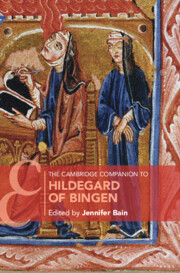Book contents
- The Cambridge Companion to Hildegard of Bingen
- The Cambridge Companion to Hildegard of Bingen
- Copyright page
- Dedication
- Contents
- Figures
- Tables
- Music Examples
- Contributors
- Acknowledgments
- Introduction
- Part I Life and Monastic Context
- Chapter 1 The Life of Hildegard of Bingen (1098–1179)
- Chapter 2 Living and Working in a Twelfth-Century Women’s Monastic Community
- Chapter 3 Literacy and Learning in the Lives of Women Religious in Medieval Germany
- Part II Writings and Reputation
- Part III Music, Manuscripts, Illuminations, and Scribes
- Select Bibliography
- Index
- Cambridge Companions To …
- References
Chapter 2 - Living and Working in a Twelfth-Century Women’s Monastic Community
from Part I - Life and Monastic Context
Published online by Cambridge University Press: 28 October 2021
- The Cambridge Companion to Hildegard of Bingen
- The Cambridge Companion to Hildegard of Bingen
- Copyright page
- Dedication
- Contents
- Figures
- Tables
- Music Examples
- Contributors
- Acknowledgments
- Introduction
- Part I Life and Monastic Context
- Chapter 1 The Life of Hildegard of Bingen (1098–1179)
- Chapter 2 Living and Working in a Twelfth-Century Women’s Monastic Community
- Chapter 3 Literacy and Learning in the Lives of Women Religious in Medieval Germany
- Part II Writings and Reputation
- Part III Music, Manuscripts, Illuminations, and Scribes
- Select Bibliography
- Index
- Cambridge Companions To …
- References
Summary
This chapter imagines an ordinary day in the life of a female monastic community in twelfth-century Germany. The chapter, like the monastic day, is organized around the celebration of the monastic liturgy of the hours. Between the liturgical hours in the oratory, the nuns attend to their daily business in the cloister, chapter house, lavatory, refectory, and workshops. The flow and activities of this monastic day are based primarily on the Rule of St. Benedict, the customary of Hirsau, and Hildegard of Bingen’s own commentary on the Rule of St. Benedict, as well as on archaeological and bioarchaeological evidence that reflects medieval monastic lifeways.
- Type
- Chapter
- Information
- The Cambridge Companion to Hildegard of Bingen , pp. 37 - 51Publisher: Cambridge University PressPrint publication year: 2021



